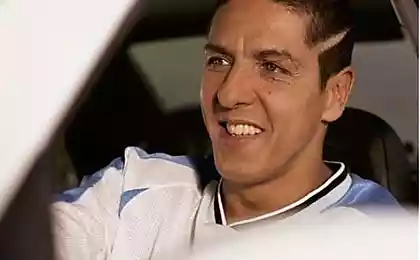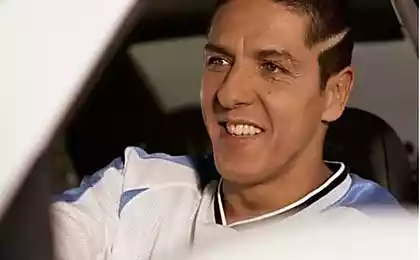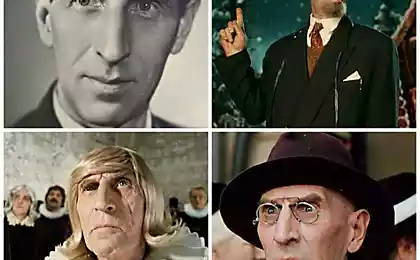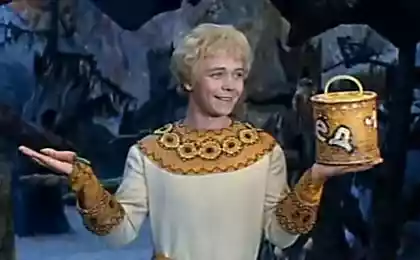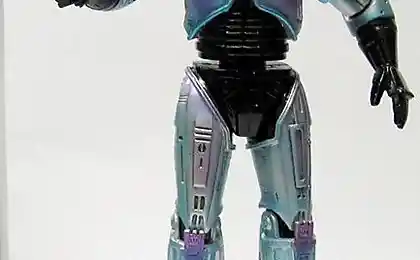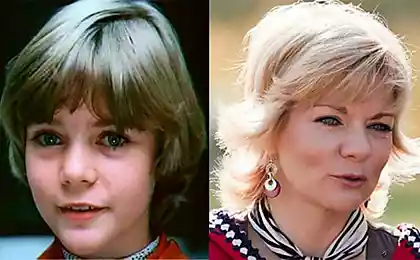1203
How to create a "robot - the police" (18 photos)
"RoboCop - the answer to the movies with Clint Eastwood and Bronson Chalz - says Ed Nyumayer. - When Dirty Harry wanted a cup of coffee, he first killed five that blocked his path to the cafe. It was overkill. Genre Action began to turn into something absurd. I wanted to "Robocop" looked like a comic book film "Iron Man" and "Spider-Man." A sort of a superhero with problems ».
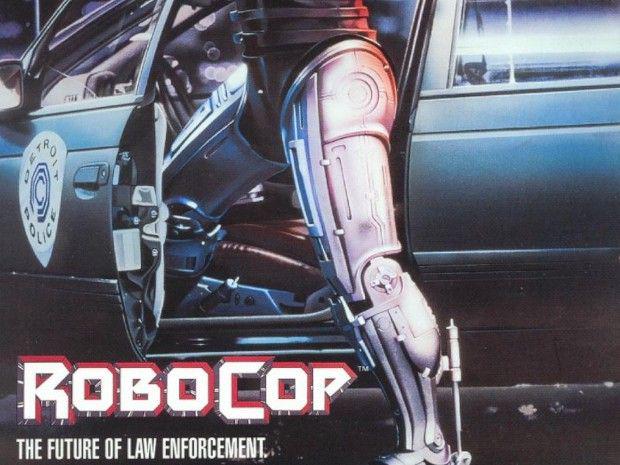
In those days, young comics creators made new heroes and comic books themselves are not designed for children. As the time to write the script "robot politseykogo" released "Terminator." But the sponsors have decided that they will not watch the "Terminator", until they finish the manuscript, so that the film James Cameron (James Cameron) did not affect them.
Producer for the "Robocop" they found quite quickly, but the director had to sweat.
"No one wanted to make a film with such trash name - says producer Jon Davison (Jon Davison). - I think they do not even open the script before the refuse, representing the name on his resume. And we are all the time trying to find a new name that would not look so second-rate, but have not been able ».
Paul Verhoeven (Paul Verhoeven), too, at first refused. After reading the first pages of the script, he threw it on the floor in disgust, finding offensive vtorosortschinoy. He did not like science fiction. "This is not my genre" - he would say later. But his wife read the script through and persuaded her husband in the presence of multiple layers and depth in this manuscript, as well as - in the presence of what he liked - satire on modern society. In the end, Verhoeven has agreed to take dystopia about the police. It was his first fiction film (surprisingly, Verhoeven, despite his dislike of the genre managed to remove three very good science fiction movie, however, like Ridley Scott's example before us is also available). John Davis himself was surprised unexpectedly agreed Dutchman.
In recognition of Verhoeven, with the creation of this film, he was inspired by classics such as "Metropolis" and "The Day the Earth Stood Still." Particularly inspired his first. He wanted me to like a robot "Metropolis", a robot with one hand personified impersonal, in this case - law, but on the other - was a personality shines through the metal armor.
Actor for the lead role, too, opted for a long time. First, they wanted to call Arnold Schwarzenegger (Arnold Schwarzenegger) and Michael Ironside (Michael Ironside), but quickly realized that they need someone to lean, so it can be put on the armor, which in this case would allow a person to move in. As a result, called Peter Weller (Peter Weller), has the time to shoot in fiction, as well as owned the martial arts. While designed suit, Peter worked with a coach and mime, as once it was clear that much of this character will be transferred to the movement, not the person.
Rob Bottin. Design and survey costume

Full-size sculpture of Rob Bottini
Costume Design Robocop engaged Rob Bottin (Rob Bottin) (whose work we have already described in the material for the film "Legend"), and this time the character was given to him very hard. Rob made a few full-size sculptures costume, which is not highly liked Verhoeven: the first costume design resembled a comic book character "Judge Dredd" and was too massive. With each new version of Rob ever closer to what we finally see on the screen. But this work took him a few months and only a few steps of the processing, the suit was approved by Verhoeven. But over the months they were harassed each other nerves, Rob refused to appear on the set and talk with Paul Verhoeven. Instead Weller dressed in costume make-up artists from his workshop.

Rob Bottin on the set
But Rob had to take care not only about the appearance of the suit, but also on how it is attached to the actor as an actor in this will move and how costume sustain action scenes, numerous fights and chases. The result was made a replica of the body of Peter Weller Plexiglas on which measured the all parts of the costume.
Rob created the lower Robocop suit of rubberized material that resembles diving, belts were worn on top of it, on which were mounted armor, molded Plexiglas and painted under the metal. Sometimes it is necessary to wipe the oil, so that it shone as necessary.
In the end, with all the delays and conflicts between the director and designer, the costume was completed and approved by only a week before the shooting. And all the parts of the robot police arrived on the set only on the day of the shooting.
The process of dressing Peter Weller in RoboCop suit for the first time took 11 hours. And when Peter appeared before the cameras on the first day of filming, all the movements that he spent several weeks rehearsing with the mime, it was impossible to do. Peter complained, asking for more time to get used and the dress rehearsal, but production group insisted on the set - it was necessary to maintain the schedule.
Later, Paul Verhoeven realized his mistake. "Of course, Peter had every right to protest - he said. - Then we treated him with contempt. " Paul gave Peter two days of training, stop shooting, which resulted in a two-day lag in the Scene at the very beginning of production. Peter trained tirelessly, practicing movements, so that they look good on the screen. He found a "bird" of the movement of the hero.
"RoboCop" was shot in Dallas during the hottest time of the year. The room temperature reaches 43 ° C. Peter Weller lost several kilograms of weight every day due to dehydration. In between takes, he sat in a trailer with his hose, feeding cold air under his rubber suit. He also tried not to go out of the image by asking to call himself on the set of "Robo", and refused to respond to his name. Between takes, he sat staring into infinity, not reacting to what is happening around. However, from this tactic, he eventually refused.
In addition, Weller could not sit in the car, when he was fully dressed - suit was too big for that. Therefore, in the film we see a robot or sitting down, or have emerged from the car. To remove the robot policeman inside the car, with it, you must remove the entire lower part of the costume. It is also quite easy to go down the stairs, because the robot should not have to look at the steps. In these scenes, Peter Weller was again wearing only the upper part of the suit.
Toward the end of the film the robot removes the broken helmet and shows us the face. For these scenes on his head, Peter wore a tight cap on top of which the rear dressed back of the head of the robot. A front to create the illusion that the skin on top of Murphy is a metal, its makeup using makeup applicator of latex foam. Makeup of the process took six and a half hours.
"I came to work at two o'clock, - says Peter. - After a six-hour process of packing in my tires, I had a short break, after which I have makeup and dressed in a suit. As a result, before shooting I practiced eight hours. Shooting lasted five hours, after which the tires started to fall off and kukozhitsya ».
Pyrotechnics
In the movie "Robocop" all the time something explodes. Scouts in Dallas found the abandoned quarter that embellishing and turned into a testing ground for the fireworks. Every day, a group of film production fell in the news for the next night's explosion.
And when another cloud of fire (it is the explosion of a gas station personnel) still singed nearby house, the fire department of the city almost shut down production of the film. But in the end everything worked out.
Also for the film it has been spent a huge amount of mini-charges and bags of fake blood. And she manages all this troublesome economy Dale Martin (Dale Martin) - Supervisor pyrotechnics on the set.

The charges on the protective vest and an explosion
In order to remove the frames in which the actor Leaky bullets on a stuntman wear a protective vest, over which with the help of tape glued plastic bags with kinokrovyu and top them secure the mini-fuses, wiring connections with the "switch" are in the hands of an assistant pyrotechnics. At the right moment Assistant closes the contact and the charge explodes, tearing clothes and a plastic bag. On the screen we see a trace bullets and blood pouring from the wound. Sometimes stuntman stitch machine gun, and then he carries back a few meters. This is achieved by multiple charges and a special cable, which is attached behind and knocks on the actor placed out of sight of the camera mats.
Background picture Rocco Dzhioffre
Generally, horse himself admits that he was lucky with the producer because he had no idea that it is necessary to create such a tape. A Davison well versed in special effects and know exactly who is invited to the project.
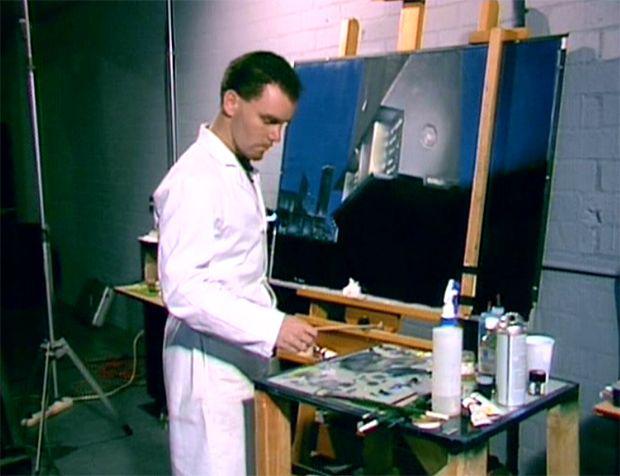
Rocco Dzhioffre the work
Since the project appeared a young, but very talented artist Dzhioffre Rocco (Rocco Gioffre) with the work we are already familiar with the film "Blade Runner." He also wrote matte paintings for famous bands, from "Close Encounters of the Third Kind", ending with Burton's "Alice in Wonderland", which has just been published, including "The Chronicles of Riddick," "Cliffhanger" and "Star Trek».
We have already mentioned that when writing background paintings for the movie (matte paintings) must take into account not only the laws of the image of reality (linear perspective, aerial and color) as well as the psychology of the perception of the viewer. In addition, it is necessary to take into account a number of technical and technological details of the production of optical compositing using matte painting.

The interior of one of the buildings of the film. Part of the left - the work of Rocco
Rocco Dzhioffre applied here the experience gained while working on "Blade Runner" - he wrote his paintings in the negative, to save one copy, and does not degrade the quality of the final copy of compositing.

The building of the police department. At the top - the original building, the bottom two works Rocco Dzhioffre: day and night views of the police department
"You close the black mask of the negative, unrolling the tape back, put a picture on an easel and shoot it so that the picture fits in black, previously unexposed space - says Rocco. - Sometimes it takes five or six tests, to fit under the edge of the mask pattern and merge it imperceptibly ».
The area of responsibility also included Rocco doll Dick Jones loss last scene from the window at the end of the film. It was a puppet for the time-lapse shooting, made of latex with articulated skeleton inside.

Animation drop
Creating a robot ED209
ED 209 was created by Craig Hayes (Craig Hayes), thereby animator Phil Tippett studio (Phil Tippett), which later came up with the joystick to the dinosaurs in "Jurassic Park."
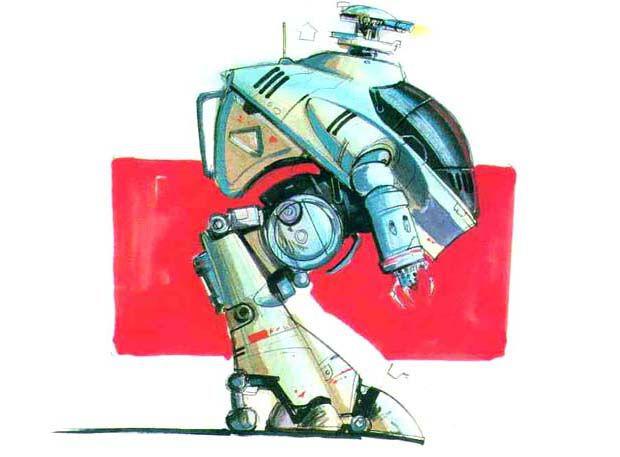
Concept Design Craig Hayes. In this embodiment, the robot had a camera for eyes
As planned, ED 209 should be big and stupid, "like all American cars - a real product industry of the USA." For the film was made full-size doll that she could not do anything, but against which it was possible to shoot people. On set, he played the role of Paul Verhoeven - the reaction of the people we see in the picture, was a response to his actions.
"Paul Verhoeven immediately made it clear that ED209 must not be pretty or nice - says Craig Hayes. - It must be a machine that need to be afraid. But I just had an idea, I would look like a giant robot. Especially if it is - the product of American industry. First of all, it should not work well. He has to look cool, and then designers have taken care of the functionality. »
Hayes took as a basis the main lines of modern design, mixed them together and add all sorts of radiators, oil coolers, heat exchangers, "if you know where to look, you'll see." Of course, the issue came up with the eyes, but Hayes prefer them not to do. In one of the designs on top of the top of the robot has a camera, but it almost immediately removed. First, eyes betray emotions, secondly, a robot with eyes - it's a cliche and vulnerability. Hayes also overdone with the hydraulics, but he did it on purpose - so the robot has become a real product of a large corporation. At the head of the robot also has something resembling a mouth.

The full-size model ED209
"Of course, in their right mind you would not make such an open hole in such a mechanism - a vulnerability, it is directly yells" shoot here "- continues Hayes. - But this - the way I imagine Detroit. And it is to slip into the design of the robot ».
The full-size model ED209 was made of Plexiglas, plastic foam and plastic. All parts are made smaller by using a vacuum press, so that it is also plastic. But the main load-bearing structure was made of wood and iron, only around a robot - only screws that are twisted wooden base. The finished robot weighed 136 kilograms and exceed two meters in height.
Its creation took four months. The model was able to take some poses, for example, to turn his head, but this movement can only be seen towards the end of the film, when the ED 209 is close to the car of Robocop. ED 209 appears in the film three times: at the time of the presentation, in the first fight with the robot and the police closer to the end of the film, when Murphy comes to arrest Dick Jones. In total, about 55 movie scenes with ED 209.

Paul Verhoeven wins back the role of the robot at the site
"Some of the scenes were very difficult - says Phil Tippett. - They included sophisticated camera movements, we did not want to limit the expression of the movie because we planned to flip animation ».
Single-frame animation, and rear-projection
For the same drawings were made and several miniature models ED209, who participated in the time-lapse photography. Small copies of the robot had to be absolutely identical large - up to the smallest detail, to the point where the light reflected from his arms.
As a full-size model always appears in the frame in the "off", the model for animation should always begin its movement from this position and return to it at the end of the scene.
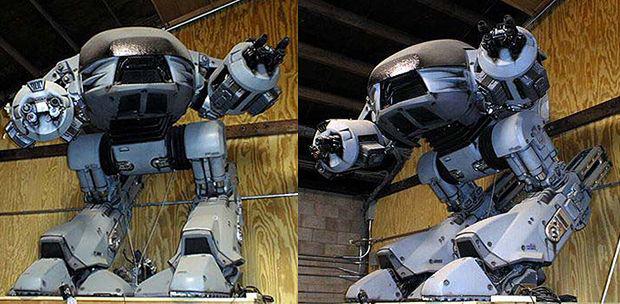
A miniature model of the robot ED209
"We did not have the money to create complex masks and shooting on Chroma, - says Phil Tippett. - So we decided to resort to the oldest and effective ways of working - the method of rear projection ».
Rear Projection is projected on a transparent screen background on the reverse side so that the model is standing in front of him, it turned out to have a background footage and thus merges with it. The camera re-photographed captured previously with the model - so a miniature model was provided in the frame along with the actors. The camera and projector were either synchronized (if the shooting was carried out at normal speed) or, as in this case, just managed independently.

Phil Tippett of the work
For this survey Tippett used projector, specially modified for time-lapse animation. After removing the frame, he pressed a button and the projector is switched to the next frame. Animator changed posture model and shoot the next frame, and again changed the picture of the projector. It is also important to highlight the model so that it coincides with the illumination light used in the frame. Otherwise, it will stand out sharply projected image, and the audience will see it.
Paul Verhoeven was first filmed with special effects. He had no idea what restrictions imposed lapse animation technology. Phil and his team had a long time to explain to the director what can and what can not be done with this technology. However, Verhoeven is constantly required to use all its capabilities to the limit. For example, Verhoeven demanded that a miniature camera and walked to the stepped through it. For this had to do special tricks - to remove from the model first foot (because it is not placed in front of the camera), then lift the leg to the knee, so the doll could step over the lens.
"Phil - he is as an actor, he creates another character in the film - says co-writer Ed Nyumayer. - He's like a clown. And the audience loved the scene on the stairs when the ED209 can not figure out how to walk on it and fall, the idea came up with Phil and it masterfully embodied ».
For this scene we built a miniature copy of the stairs. They put the doll on top, pinning his leg with a pin on the back side. When it's time to drop the robot, a pin was removed, and the doll rolled down the stairs.
"And I stood there and caught it - says Hayes. - Because of this doll I answered, and I did not want it broke, falling to the floor. Then I would have to collect the robot to double again next ».

The animation process

In those days, young comics creators made new heroes and comic books themselves are not designed for children. As the time to write the script "robot politseykogo" released "Terminator." But the sponsors have decided that they will not watch the "Terminator", until they finish the manuscript, so that the film James Cameron (James Cameron) did not affect them.
Producer for the "Robocop" they found quite quickly, but the director had to sweat.
"No one wanted to make a film with such trash name - says producer Jon Davison (Jon Davison). - I think they do not even open the script before the refuse, representing the name on his resume. And we are all the time trying to find a new name that would not look so second-rate, but have not been able ».
Paul Verhoeven (Paul Verhoeven), too, at first refused. After reading the first pages of the script, he threw it on the floor in disgust, finding offensive vtorosortschinoy. He did not like science fiction. "This is not my genre" - he would say later. But his wife read the script through and persuaded her husband in the presence of multiple layers and depth in this manuscript, as well as - in the presence of what he liked - satire on modern society. In the end, Verhoeven has agreed to take dystopia about the police. It was his first fiction film (surprisingly, Verhoeven, despite his dislike of the genre managed to remove three very good science fiction movie, however, like Ridley Scott's example before us is also available). John Davis himself was surprised unexpectedly agreed Dutchman.
In recognition of Verhoeven, with the creation of this film, he was inspired by classics such as "Metropolis" and "The Day the Earth Stood Still." Particularly inspired his first. He wanted me to like a robot "Metropolis", a robot with one hand personified impersonal, in this case - law, but on the other - was a personality shines through the metal armor.
Actor for the lead role, too, opted for a long time. First, they wanted to call Arnold Schwarzenegger (Arnold Schwarzenegger) and Michael Ironside (Michael Ironside), but quickly realized that they need someone to lean, so it can be put on the armor, which in this case would allow a person to move in. As a result, called Peter Weller (Peter Weller), has the time to shoot in fiction, as well as owned the martial arts. While designed suit, Peter worked with a coach and mime, as once it was clear that much of this character will be transferred to the movement, not the person.
Rob Bottin. Design and survey costume

Full-size sculpture of Rob Bottini
Costume Design Robocop engaged Rob Bottin (Rob Bottin) (whose work we have already described in the material for the film "Legend"), and this time the character was given to him very hard. Rob made a few full-size sculptures costume, which is not highly liked Verhoeven: the first costume design resembled a comic book character "Judge Dredd" and was too massive. With each new version of Rob ever closer to what we finally see on the screen. But this work took him a few months and only a few steps of the processing, the suit was approved by Verhoeven. But over the months they were harassed each other nerves, Rob refused to appear on the set and talk with Paul Verhoeven. Instead Weller dressed in costume make-up artists from his workshop.

Rob Bottin on the set
But Rob had to take care not only about the appearance of the suit, but also on how it is attached to the actor as an actor in this will move and how costume sustain action scenes, numerous fights and chases. The result was made a replica of the body of Peter Weller Plexiglas on which measured the all parts of the costume.
Rob created the lower Robocop suit of rubberized material that resembles diving, belts were worn on top of it, on which were mounted armor, molded Plexiglas and painted under the metal. Sometimes it is necessary to wipe the oil, so that it shone as necessary.
In the end, with all the delays and conflicts between the director and designer, the costume was completed and approved by only a week before the shooting. And all the parts of the robot police arrived on the set only on the day of the shooting.
The process of dressing Peter Weller in RoboCop suit for the first time took 11 hours. And when Peter appeared before the cameras on the first day of filming, all the movements that he spent several weeks rehearsing with the mime, it was impossible to do. Peter complained, asking for more time to get used and the dress rehearsal, but production group insisted on the set - it was necessary to maintain the schedule.
Later, Paul Verhoeven realized his mistake. "Of course, Peter had every right to protest - he said. - Then we treated him with contempt. " Paul gave Peter two days of training, stop shooting, which resulted in a two-day lag in the Scene at the very beginning of production. Peter trained tirelessly, practicing movements, so that they look good on the screen. He found a "bird" of the movement of the hero.
"RoboCop" was shot in Dallas during the hottest time of the year. The room temperature reaches 43 ° C. Peter Weller lost several kilograms of weight every day due to dehydration. In between takes, he sat in a trailer with his hose, feeding cold air under his rubber suit. He also tried not to go out of the image by asking to call himself on the set of "Robo", and refused to respond to his name. Between takes, he sat staring into infinity, not reacting to what is happening around. However, from this tactic, he eventually refused.
In addition, Weller could not sit in the car, when he was fully dressed - suit was too big for that. Therefore, in the film we see a robot or sitting down, or have emerged from the car. To remove the robot policeman inside the car, with it, you must remove the entire lower part of the costume. It is also quite easy to go down the stairs, because the robot should not have to look at the steps. In these scenes, Peter Weller was again wearing only the upper part of the suit.
Toward the end of the film the robot removes the broken helmet and shows us the face. For these scenes on his head, Peter wore a tight cap on top of which the rear dressed back of the head of the robot. A front to create the illusion that the skin on top of Murphy is a metal, its makeup using makeup applicator of latex foam. Makeup of the process took six and a half hours.
"I came to work at two o'clock, - says Peter. - After a six-hour process of packing in my tires, I had a short break, after which I have makeup and dressed in a suit. As a result, before shooting I practiced eight hours. Shooting lasted five hours, after which the tires started to fall off and kukozhitsya ».
Pyrotechnics
In the movie "Robocop" all the time something explodes. Scouts in Dallas found the abandoned quarter that embellishing and turned into a testing ground for the fireworks. Every day, a group of film production fell in the news for the next night's explosion.
And when another cloud of fire (it is the explosion of a gas station personnel) still singed nearby house, the fire department of the city almost shut down production of the film. But in the end everything worked out.
Also for the film it has been spent a huge amount of mini-charges and bags of fake blood. And she manages all this troublesome economy Dale Martin (Dale Martin) - Supervisor pyrotechnics on the set.

The charges on the protective vest and an explosion
In order to remove the frames in which the actor Leaky bullets on a stuntman wear a protective vest, over which with the help of tape glued plastic bags with kinokrovyu and top them secure the mini-fuses, wiring connections with the "switch" are in the hands of an assistant pyrotechnics. At the right moment Assistant closes the contact and the charge explodes, tearing clothes and a plastic bag. On the screen we see a trace bullets and blood pouring from the wound. Sometimes stuntman stitch machine gun, and then he carries back a few meters. This is achieved by multiple charges and a special cable, which is attached behind and knocks on the actor placed out of sight of the camera mats.
Background picture Rocco Dzhioffre
Generally, horse himself admits that he was lucky with the producer because he had no idea that it is necessary to create such a tape. A Davison well versed in special effects and know exactly who is invited to the project.

Rocco Dzhioffre the work
Since the project appeared a young, but very talented artist Dzhioffre Rocco (Rocco Gioffre) with the work we are already familiar with the film "Blade Runner." He also wrote matte paintings for famous bands, from "Close Encounters of the Third Kind", ending with Burton's "Alice in Wonderland", which has just been published, including "The Chronicles of Riddick," "Cliffhanger" and "Star Trek».
We have already mentioned that when writing background paintings for the movie (matte paintings) must take into account not only the laws of the image of reality (linear perspective, aerial and color) as well as the psychology of the perception of the viewer. In addition, it is necessary to take into account a number of technical and technological details of the production of optical compositing using matte painting.

The interior of one of the buildings of the film. Part of the left - the work of Rocco
Rocco Dzhioffre applied here the experience gained while working on "Blade Runner" - he wrote his paintings in the negative, to save one copy, and does not degrade the quality of the final copy of compositing.

The building of the police department. At the top - the original building, the bottom two works Rocco Dzhioffre: day and night views of the police department
"You close the black mask of the negative, unrolling the tape back, put a picture on an easel and shoot it so that the picture fits in black, previously unexposed space - says Rocco. - Sometimes it takes five or six tests, to fit under the edge of the mask pattern and merge it imperceptibly ».
The area of responsibility also included Rocco doll Dick Jones loss last scene from the window at the end of the film. It was a puppet for the time-lapse shooting, made of latex with articulated skeleton inside.

Animation drop
Creating a robot ED209
ED 209 was created by Craig Hayes (Craig Hayes), thereby animator Phil Tippett studio (Phil Tippett), which later came up with the joystick to the dinosaurs in "Jurassic Park."

Concept Design Craig Hayes. In this embodiment, the robot had a camera for eyes
As planned, ED 209 should be big and stupid, "like all American cars - a real product industry of the USA." For the film was made full-size doll that she could not do anything, but against which it was possible to shoot people. On set, he played the role of Paul Verhoeven - the reaction of the people we see in the picture, was a response to his actions.
"Paul Verhoeven immediately made it clear that ED209 must not be pretty or nice - says Craig Hayes. - It must be a machine that need to be afraid. But I just had an idea, I would look like a giant robot. Especially if it is - the product of American industry. First of all, it should not work well. He has to look cool, and then designers have taken care of the functionality. »
Hayes took as a basis the main lines of modern design, mixed them together and add all sorts of radiators, oil coolers, heat exchangers, "if you know where to look, you'll see." Of course, the issue came up with the eyes, but Hayes prefer them not to do. In one of the designs on top of the top of the robot has a camera, but it almost immediately removed. First, eyes betray emotions, secondly, a robot with eyes - it's a cliche and vulnerability. Hayes also overdone with the hydraulics, but he did it on purpose - so the robot has become a real product of a large corporation. At the head of the robot also has something resembling a mouth.

The full-size model ED209
"Of course, in their right mind you would not make such an open hole in such a mechanism - a vulnerability, it is directly yells" shoot here "- continues Hayes. - But this - the way I imagine Detroit. And it is to slip into the design of the robot ».
The full-size model ED209 was made of Plexiglas, plastic foam and plastic. All parts are made smaller by using a vacuum press, so that it is also plastic. But the main load-bearing structure was made of wood and iron, only around a robot - only screws that are twisted wooden base. The finished robot weighed 136 kilograms and exceed two meters in height.
Its creation took four months. The model was able to take some poses, for example, to turn his head, but this movement can only be seen towards the end of the film, when the ED 209 is close to the car of Robocop. ED 209 appears in the film three times: at the time of the presentation, in the first fight with the robot and the police closer to the end of the film, when Murphy comes to arrest Dick Jones. In total, about 55 movie scenes with ED 209.

Paul Verhoeven wins back the role of the robot at the site
"Some of the scenes were very difficult - says Phil Tippett. - They included sophisticated camera movements, we did not want to limit the expression of the movie because we planned to flip animation ».
Single-frame animation, and rear-projection
For the same drawings were made and several miniature models ED209, who participated in the time-lapse photography. Small copies of the robot had to be absolutely identical large - up to the smallest detail, to the point where the light reflected from his arms.
As a full-size model always appears in the frame in the "off", the model for animation should always begin its movement from this position and return to it at the end of the scene.

A miniature model of the robot ED209
"We did not have the money to create complex masks and shooting on Chroma, - says Phil Tippett. - So we decided to resort to the oldest and effective ways of working - the method of rear projection ».
Rear Projection is projected on a transparent screen background on the reverse side so that the model is standing in front of him, it turned out to have a background footage and thus merges with it. The camera re-photographed captured previously with the model - so a miniature model was provided in the frame along with the actors. The camera and projector were either synchronized (if the shooting was carried out at normal speed) or, as in this case, just managed independently.

Phil Tippett of the work
For this survey Tippett used projector, specially modified for time-lapse animation. After removing the frame, he pressed a button and the projector is switched to the next frame. Animator changed posture model and shoot the next frame, and again changed the picture of the projector. It is also important to highlight the model so that it coincides with the illumination light used in the frame. Otherwise, it will stand out sharply projected image, and the audience will see it.
Paul Verhoeven was first filmed with special effects. He had no idea what restrictions imposed lapse animation technology. Phil and his team had a long time to explain to the director what can and what can not be done with this technology. However, Verhoeven is constantly required to use all its capabilities to the limit. For example, Verhoeven demanded that a miniature camera and walked to the stepped through it. For this had to do special tricks - to remove from the model first foot (because it is not placed in front of the camera), then lift the leg to the knee, so the doll could step over the lens.
"Phil - he is as an actor, he creates another character in the film - says co-writer Ed Nyumayer. - He's like a clown. And the audience loved the scene on the stairs when the ED209 can not figure out how to walk on it and fall, the idea came up with Phil and it masterfully embodied ».
For this scene we built a miniature copy of the stairs. They put the doll on top, pinning his leg with a pin on the back side. When it's time to drop the robot, a pin was removed, and the doll rolled down the stairs.
"And I stood there and caught it - says Hayes. - Because of this doll I answered, and I did not want it broke, falling to the floor. Then I would have to collect the robot to double again next ».

The animation process








